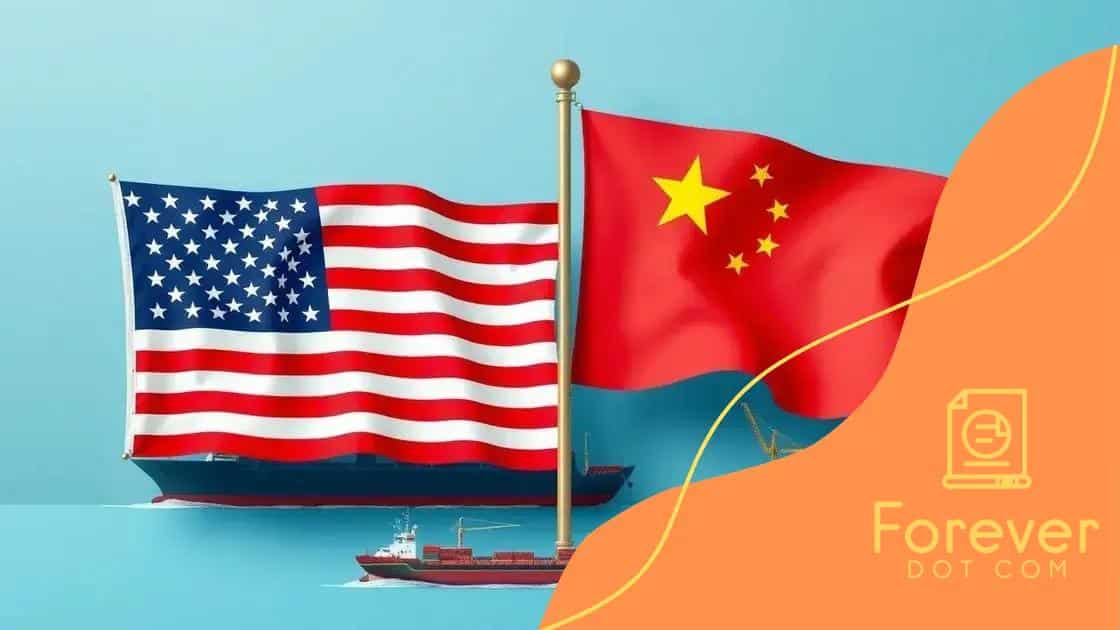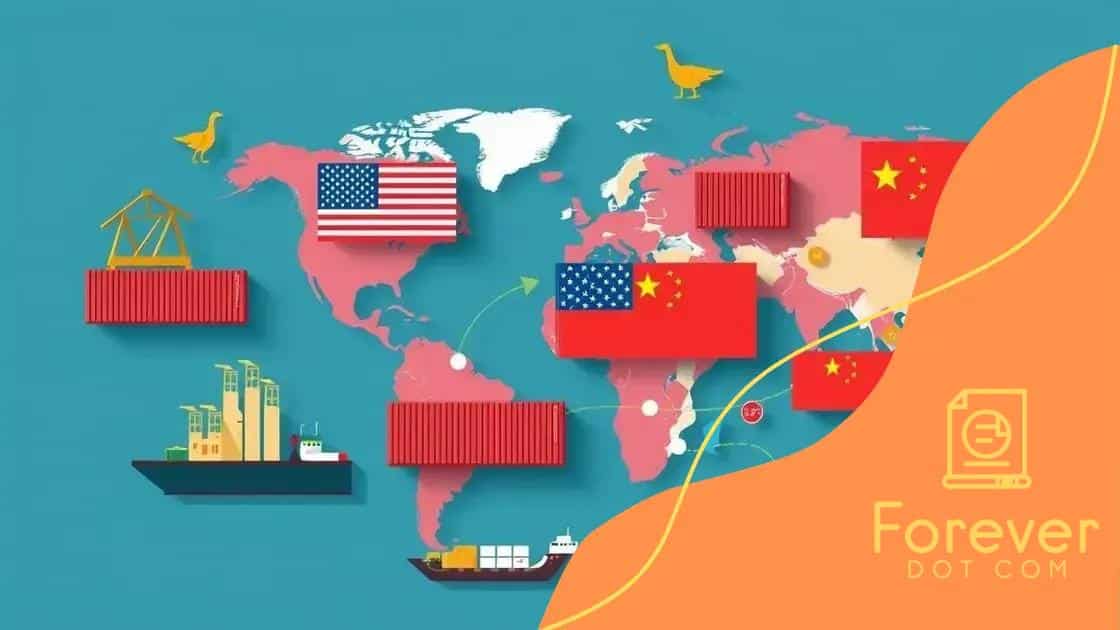US-China trade tensions grow amid economic uncertainty

US-China trade tensions grow due to economic competition, intellectual property disputes, and geopolitical factors, significantly impacting global supply chains and economies while prompting the need for potential resolutions and collaborations.
US-China trade tensions grow and are more relevant than ever, raising questions about future economic stability. Have you thought about how these tensions affect global trade and your everyday life? Let’s dive into this complex issue and unravel its implications.
Overview of US-China trade relations
The overview of US-China trade relations is crucial for understanding the broader economic landscape. These two nations have long been the largest economies in the world, and their trade relations significantly impact global markets.
Historical Context
Trade between the US and China has evolved dramatically since China joined the World Trade Organization in 2001. This change allowed China to rapidly expand its export capabilities, leading to a surge in US imports. As a result, the trade relationship became increasingly complex and multifaceted.
Current Trade Dynamics
Today, the trade relationship is marked by both competition and cooperation. While both countries benefit economically, tensions have risen over various issues.
- Trade imbalances and deficits
- Intellectual property concerns
- Tariffs and trade barriers
These elements contribute to a landscape of growing tensions between the nations. For instance, tariffs imposed in recent years have led to price increases for consumers and challenges for businesses reliant on imports.
Future Direction
Looking ahead, the future of US-China trade relations remains uncertain. Factors such as geopolitical issues, technological advancements, and domestic policies will play significant roles in shaping the path forward. As both nations continue to navigate these challenges, it’s crucial to keep an eye on how these developments will affect not only their economies but also the global market.
Key factors behind growing tensions
The key factors behind growing tensions between the US and China are numerous and complex. Understanding these factors helps illuminate why trade relations are strained today.
Economic Competition
At the forefront is fierce economic competition. The US has long been a global leader, but China’s rapid growth has changed the dynamics. This competition often leads to protective measures like tariffs, aiming to shield domestic industries.
Intellectual Property Issues
Another significant point of contention is the issue of intellectual property. The US accuses China of unfair practices, such as stealing technology and not enforcing copyright laws adequately. This has frustrated American companies and policymakers alike.
- Increased concerns over cybersecurity
- Unresolved cases of patent theft
- Pressure for technology transfer
These issues intensify the sentiment of distrust between the two nations. They shape public perception and policy decisions, making resolution difficult.
Geopolitical Factors
Geopolitical tensions also play a crucial role. Conflicts over territories in the South China Sea and differing political ideologies further complicate relationships. Each country’s actions in these regions can provoke reactions, escalating the situation.
Furthermore, the global response to China’s rising influence has led to strategic alliances among US allies, as they seek to counterbalance China’s power. As these dynamics evolve, they contribute to an unstable environment.
Impact on global supply chains

The impact on global supply chains due to US-China trade tensions has been profound and far-reaching. As the world’s two largest economies engage in conflict, the consequences ripple through industries worldwide.
Disruptions in Manufacturing
Manufacturers, especially those relying heavily on components from either country, face significant challenges. Tariffs can raise costs, causing businesses to reevaluate their supply sources. Many companies are now seeking alternatives to Chinese suppliers, which can lead to delays and increased prices.
Shift in Trade Patterns
As tariffs change the landscape, trade patterns are shifting. Countries such as Vietnam and India are becoming popular alternatives for manufacturing. This transition often involves establishing new partnerships and logistics networks.
- Increased reliance on trade deals with other nations
- Emerging markets gaining importance
- Changes in shipping routes due to tariffs
These shifts can create an environment of uncertainty as businesses navigate new relationships. Furthermore, the companies that adapt quickly may have advantages, while others may struggle to keep up.
Increased Costs for Consumers
As tensions escalate, consumers often end up paying the price. Rising costs in production can lead to higher prices for everyday goods. This situation presents a challenge as consumers weigh their options in the market, potentially affecting their buying decisions.
In summary, the ongoing US-China trade tensions are reshaping global supply chains, leading to disruptions, shifts in trade patterns, and increased consumer costs. Understanding these implications is crucial for businesses and consumers alike.
Economic consequences for both nations
The economic consequences for both nations are significant and multifaceted due to the growing tensions between the US and China. These effects can be observed across various sectors and can influence global economic stability.
Impact on GDP
As trade barriers rise, both the US and China may experience slowed economic growth. For instance, higher tariffs increase costs for businesses and consumers alike. This can lead to a decrease in overall consumption, impacting gross domestic product (GDP) in both countries.
Industry-Specific Effects
Different industries feel the strain in various ways. The agriculture sector in the US has faced challenges due to lost access to Chinese markets for products like soybeans. Conversely, Chinese technology firms may struggle under pressure from US sanctions, which could stifle innovation and growth.
- Manufacturing jobs at risk due to shifting production
- Increased prices for electronics and consumer goods
- Pressure on small businesses reliant on imports
These dynamics contribute to an unstable economic environment, leading some companies to rethink their supply chains and strategies.
Global Market Effects
The impact of US-China trade tensions extends beyond their borders. Economies around the world can feel the effects, as disrupted supply chains affect international trade flows. Countries that export to either China or the US may face reduced demand for their goods.
As these nations navigate the economic challenges, understanding the consequences is vital for businesses, policymakers, and consumers alike.
Future outlook and potential resolutions
The future outlook and potential resolutions for US-China trade tensions remain uncertain yet critical for both nations and the global economy. Both countries will need to navigate complex scenarios and find pathways to cooperation.
Changing Trade Policies
As tensions evolve, there is a possibility of shifting trade policies. Both governments may consider negotiations to reduce tariffs and foster a more collaborative environment. This can help stabilize markets and encourage businesses to invest.
International Collaboration
Another avenue for resolution is through international collaboration. Working with global organizations and other nations could lead to multilateral trade agreements that benefit all parties involved. This approach can help ease bilateral tensions and promote shared economic growth.
- Engaging in diplomatic dialogues
- Establishing frameworks for fair trade
- Enhancing transparency in trade practices
Additionally, cooperation on common challenges, such as climate change and public health, could build trust and foster better relations between the two countries.
Technological Innovation
Investing in technological innovation will also play a key role in shaping the future. Both the US and China can focus on developing new technologies that drive economic growth while ensuring fair practices to protect intellectual property rights.
Finding a balance between competition and collaboration will be essential for a sustainable and prosperous future. As international dynamics change, keeping an eye on developments in US-China relations will be vital for businesses and consumers alike.
Conclusion: The US-China trade tensions present significant challenges and opportunities for both countries. The economic implications are vast, affecting industries and consumers everywhere. By focusing on collaboration, fair trade practices, and technological advancements, both nations can work towards a more stable economic future. Navigating this complex landscape requires careful consideration and cooperation from all parties involved, as the effects of these tensions will continue to shape the global economy.
FAQ – Frequently Asked Questions about US-China Trade Tensions
What are the main causes of the US-China trade tensions?
The main causes include economic competition, intellectual property issues, and geopolitical factors that create mistrust between the two nations.
How do these tensions affect global markets?
US-China trade tensions can lead to disruptions in supply chains, increased costs for consumers, and shifts in trade patterns that impact economies worldwide.
What potential solutions might help ease these tensions?
Potential solutions include diplomatic negotiations, international collaborations, and focusing on technological innovation and fair trade practices.
How can businesses prepare for future changes due to these tensions?
Businesses can prepare by diversifying their supply chains, exploring new markets, and staying informed about trade policy changes and economic forecasts.






